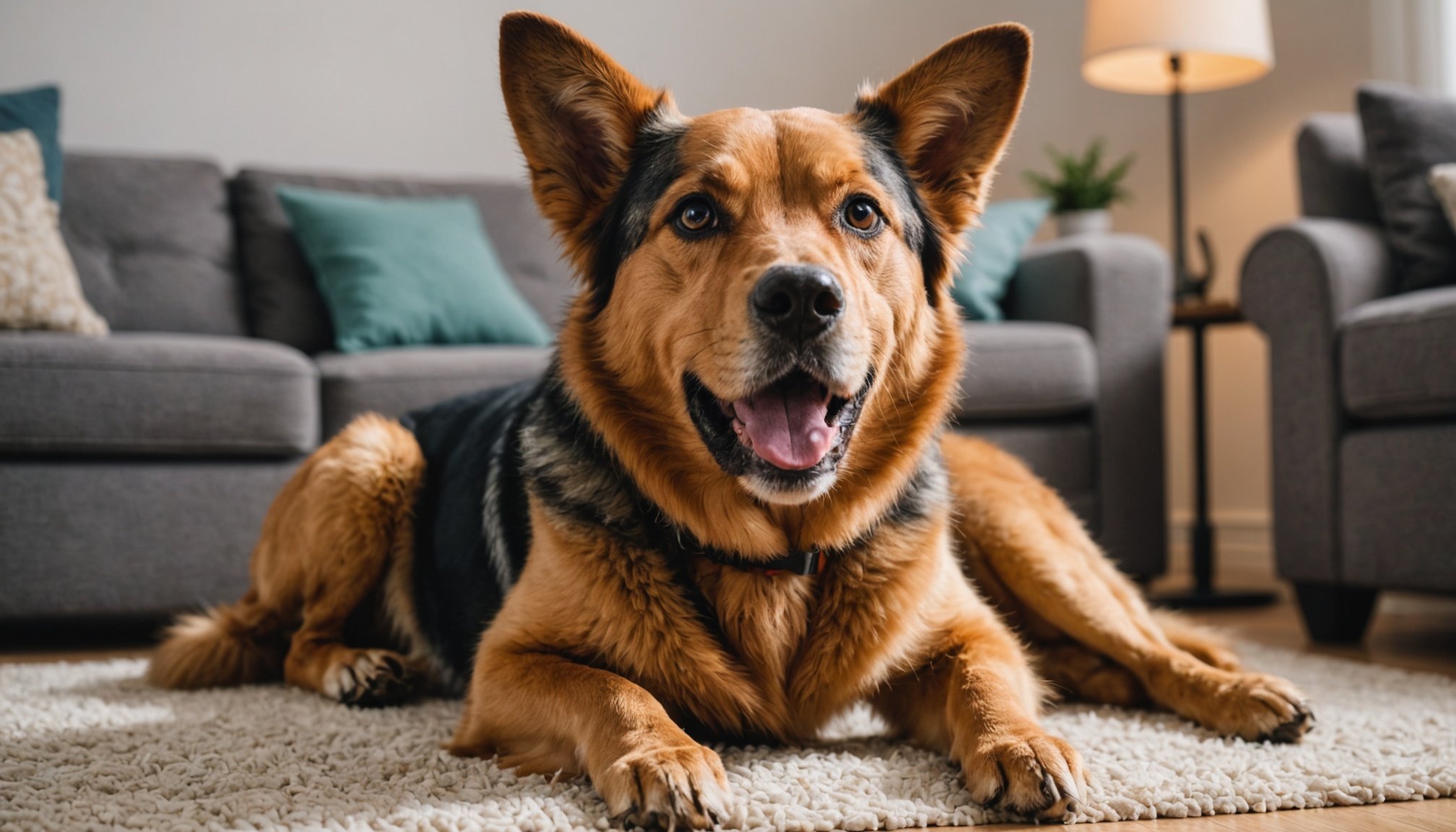Understanding Dog Anxiety Related to Loud Noises
Many dogs experience anxiety and fear of loud noises, which can range from mild discomfort to extreme panic. Common sources of noise-related fear include thunderstorms, fireworks, and household appliances like vacuum cleaners. Understanding the signs that indicate a dog’s anxiety during these events is crucial in administering the appropriate care.
Dogs might exhibit behaviors such as trembling, hiding, excessive barking, or destructive behavior when they experience noise sensitivity. These signs may become apparent as soon as a loud noise occurs, signaling distress. Environmental factors also play a significant role in a dog’s noise sensitivity. For instance, a dog living in a busy urban area might develop a heightened fear compared to a dog residing in a quieter environment.
Additional reading : The ultimate guide to safe chew toys for comforting teething puppies: your go-to resource
In mitigating this anxiety, it’s important to foster a nurturing atmosphere and adopt strategies that help your pet feel secure. Implementing calming practices and creating a sanctuary within the home can alleviate some of the stress associated with loud noises. Such an approach helps curb the development of chronic anxiety, promoting a healthier relationship between the environment and your dog.
Techniques for Effective Desensitization
Effective desensitization is crucial for managing dog anxiety related to loud noises. This method involves gradual exposure, where dogs are introduced to increasing levels of noise over time. The aim is to acclimatize dogs slowly, allowing them to build tolerance and reduce their fear responses to anxiety-inducing sounds.
In parallel : Ultimate guide to beagle training: proven techniques to reduce excessive barking at strangers
Gradual Exposure Techniques
To practice gradual exposure, start by playing recordings of the feared noises at a low volume. Gradually increase the volume over weeks, ensuring your dog remains calm at each stage. A relaxed approach encourages confidence and reduces the anxiety associated with sudden loud noises.
Positive Reinforcement Strategies
Pair gradual exposure with positive reinforcement to enhance behavioral modification. Use treats and praise when your dog remains calm during noise exposure. Positive behaviors are thus rewarded, reinforcing calm responses and aiding anxiety management.
Step-by-Step Instructions for Implementing Techniques
- Begin by selecting recordings of noises your dog fears.
- Play these sounds at a minimal, barely audible level.
- Observe your dog’s behavior; if calm, gradually increase the sound.
- Whenever your dog remains relaxed, reward with a treat or praise.
- Ensure progression at a comfortable pace, retreating if signs of anxiety resurface.
These techniques foster a resilient, confident response to loud noises, paving the way for a stress-free environment.
Creating a Calm Environment
Establishing a calm environment is pivotal for managing a dog’s anxiety related to loud noises. A safe space acts as a refuge, offering security during distressing events. This dedicated area should be comfortable, using familiar bedding and toys to foster a sense of familiarity.
Techniques for Soundproofing
Minimising noise exposure can significantly reduce a dog’s anxiety. Consider investing in soundproofing solutions such as heavy curtains, carpets, or rugs that absorb sound. Sealing windows and using draft stoppers under doors can further block out external noises.
Environmental Adjustments to Support Anxiety Management
Environmental adjustments play a vital role in supporting a dog’s anxiety management. Aromatherapy or diffusers with calming scents like lavender can provide a soothing atmosphere. Adjusting lighting to a gentle dimness can also have a calming effect. Utilizing white noise machines or soft music can drown out stress-inducing sounds, promoting relaxation.
Implementing these calming strategies not only eases a dog’s immediate stress but also helps in long-term behavioural modification by reducing overall anxiety levels. Fostering an environment dedicated to comfort and safety encourages a dog to associate their home with security, ultimately aiding in decreasing noise sensitivity.
Expert Insights and Personal Anecdotes
Understanding dog anxiety and its connection to loud noises can be better explained by experts and real-life examples. Veterinarians and animal behaviorists provide invaluable expert advice on managing these issues. They emphasise the importance of early intervention using methods such as desensitization and gradual exposure. This approach can help reduce anxiety levels over time, fostering a calmer demeanor in dogs.
In practical terms, success stories from dog owners further reveal the benefits of applying professional tips and strategies. For instance, one dog owner, after consulting with a behaviorist, implemented a behavioral modification plan focusing on patience and consistency. Over months, their pet’s fear of loud noises diminished significantly.
Real-world experiences, shared by dog owners, highlight innovative solutions tailored to individual needs. Some have found success by integrating safe spaces and modifying environments, others through daily training routines that incorporate positive reinforcement. These stories underscore the personalized nature of managing anxiety, demonstrating that with persistence and informed guidance, improvements are possible.
By combining professional insights with personal experiences, a broader understanding of managing dog anxiety related to noise emerges, offering hope and practical solutions for pet owners facing similar challenges.
Frequently Asked Questions
When addressing the concerns around dog noise anxiety, understanding these FAQs helps demystify common beliefs. Can all dogs experience noise anxiety? While not every dog has this sensitivity, it is a widespread issue influenced by breed, upbringing, and experiences. Certain breeds may be predisposed to fear of loud noises, but environmental factors and past traumas can play substantial roles.
When should dog owners seek professional help? If your dog’s response involves extreme panic or poses safety risks, consult a veterinarian or animal behaviorist. They can provide specialized anxiety management plans tailored to individual needs.
Are there immediate solutions for events like thunderstorms? During such occurrences, temporary relief options include creating a safe space for your dog, using noise-dampening tools, or applying approved calming agents. Maintaining a consistent, comforting presence can also ease their distress.
These answers highlight the importance of timely intervention and understanding your pet’s unique needs. For full behavioral modification, comprehensive strategies like desensitization are crucial, ensuring long-lasting solutions beyond temporary fixes. Ensuring your pet’s well-being requires patience, care, and sometimes, professional guidance.
Resources for Further Reading
Exploring additional training resources can significantly bolster your understanding of effective anxiety management and desensitization strategies. Here’s a concise guide to help enrich your knowledge and offer practical solutions.
Recommended Books
For those interested in dog training and behaviour, several books can provide detailed insights. Titles such as “The Dog Trainer’s Complete Guide to a Happy, Well-Behaved Pet” offer practical tips and deep dives into behavioral modification tactics. These resources emphasise positive reinforcement and gradual exposure as pivotal methods for managing fear of loud noises.
Online Courses and Workshops
Enrol in online courses like “Understanding Canine Anxiety” to gain expert-led guidance on desensitization and behavioral modification. These courses often feature interactive content, enabling dog owners to practice learned techniques in real-world scenarios. Workshops provide a community atmosphere where you can learn from other pet owners and experts alike.
Useful Websites
Websites such as the ASPCA and RSPCA offer comprehensive articles on managing dog anxiety, recommending relevant training strategies and products. Further, platforms like Udemy host classes specifically tailored to canine anxiety and positive reinforcement techniques.
Engaging with these diverse resources enhances your capacity to create a supportive environment for your furry companion, promoting effective anxiety management.
Importance of Desensitization
Desensitization is a valued approach in anxiety management for dogs, focusing on reducing their sensitivity to fear-inducing stimuli. This method employs gradual exposure to gradually introduce noise stimuli, fostering a tolerance over time and lessening adverse reactions.
How Desensitization Works
The process of desensitization involves repeated, controlled exposure to the anxiety-provoking stimulus, in this case, loud noises. By incrementally increasing sound levels, dogs become acclimated, thereby diminishing their fear responses. This exposure should be consistent and paired with other behavioral modification strategies to reinforce positive outcomes.
Benefits of Early Desensitization
Starting desensitization early, particularly in puppies, can be remarkably beneficial. Early intervention not only prevents the escalation of dog anxiety but also aids in instilling a resilient disposition. Puppies acclimating through this controlled exposure are less likely to develop severe noise sensitivity as adults.
Role of Gradual Exposure
A systematic approach of gradual exposure is crucial in the desensitization process. This method ensures the dog remains calm throughout by carefully managing the intensity of the stimulus. By doing so, dogs build a behavioural repertoire that lowers their anxiety levels, promoting a more harmonious existence in environments prone to loud noises.

